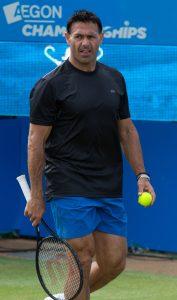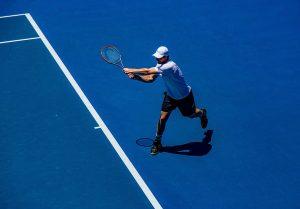We may earn money or products from the companies mentioned in this post.
A Brief Overview of Tennis as a Sport

Tennis, a sport cherished by millions worldwide, has a rich history that dates back centuries Its origins can be traced back to the game of “jeu de paume” played in 12th-century France Over time, it evolved into its modern form, with the introduction of rackets and nets
Today, tennis has become one of the most popular sports globally, captivating audiences with its fast-paced action and intense competition It is played professionally in tournaments such as the Grand Slam events – Wimbledon, Australian Open, French Open, and US Open – which attract top players from around the world
The Importance of Learning Tennis

Physical Fitness Benefits
Learning tennis provides numerous physical fitness benefits that contribute to overall well-being The sport requires agility, speed, and endurance, making it an excellent cardiovascular workout Each swing of the racket engages various muscle groups in the arms, shoulders, core, and legs
Tennis also improves coordination and balance through quick movements across the court The constant running and lateral movements improve flexibility and strengthen bones and joints Engaging in regular tennis sessions can help individuals maintain a healthy weight and reduce the risk of chronic diseases like heart disease
Mental Health Benefits
Beyond physical fitness advantages, learning tennis offers significant mental health benefits as well Playing tennis requires focus, concentration, and strategic thinking – skills that translate to improved cognitive function in other aspects of life
The game’s competitive nature helps develop resilience and mental toughness as players face challenges on the court Additionally, tennis provides an outlet for stress relief; hitting balls during practice or matches can serve as a cathartic release for pent-up emotions
Social Aspects
Tennis is not only a solitary sport; it also offers plenty of opportunities for social interaction Whether playing singles or doubles, tennis provides a platform for individuals to connect and build relationships with fellow players
Joining tennis clubs or participating in local tournaments introduces players to a community of like-minded individuals who share a passion for the sport Engaging in friendly matches and competitive play fosters teamwork, sportsmanship, and camaraderie
In conclusion, tennis goes beyond being just a sport It encompasses rich history, global reach, physical fitness benefits, mental health advantages, and social aspects that make it an engaging and rewarding activity to learn So why not grab a racket and hit the court?
Understanding the basics of tennis

Tennis is a popular sport that combines athleticism, strategy, and finesse Whether you’re a beginner or looking to brush up on your skills, understanding the basics is crucial Let’s dive into the equipment needed for self-learning, the layout of a tennis court, and the rules of the game
Equipment needed for self-learning
To start your tennis journey, it’s important to have the right equipment The main item you’ll need is a tennis racket Rackets come in various types and sizes, so selecting one that suits your playing style and skill level is essential Consider factors such as weight, grip size, and head size when choosing a racket that feels comfortable in your hand
In addition to a racket, you’ll need tennis balls for practice sessions Tennis balls also come in different types and pressure levels Opt for pressurized balls if you’re playing on a regular court surface, but if you’re practicing on softer surfaces like clay or grass, non-pressurized balls are more suitable
Lastly, don’t forget about appropriate footwear and clothing Tennis shoes provide stability and support during lateral movements on the court Comfortable clothing that allows freedom of movement will enhance your overall playing experience
The tennis court layout and dimensions
Tennis courts come in different types – clay, grass, and hard courts being the most common ones Each surface has its own characteristics that affect gameplay Clay courts are known for their slower pace due to their softness, while grass courts offer faster play with lower ball bounce Hard courts strike a balance between speed and control
Understanding the lines, markings, and scoring areas on a tennis court is crucial for gameplay The baseline divides each player’s side of the court, while the service line marks where the serve must be hit from The singles sideline and doubles alley determine the boundaries of play Additionally, there are specific areas for serving, such as the service boxes
Rules of the game
Once you have a grasp of the equipment and court layout, it’s time to delve into the rules of tennis Serving rules dictate how a player starts each point, including hitting within certain boundaries and alternating sides after each point
The scoring system in tennis can seem confusing at first, but it follows a unique pattern The game consists of points, games, and sets Understanding terms like “love,” “deuce,” and “advantage” is essential to keep track of scores during matches
Lastly, familiarize yourself with the match structure Tennis matches can be played in various formats – singles or doubles – with different numbers of sets required for victory
Developing Essential Tennis Skills by Yourself

Are you a tennis enthusiast looking to improve your game but don’t have access to a coach or training partner? Don’t worry, you can still develop essential tennis skills on your own By focusing on mastering basic strokes and improving footwork, as well as building consistency through practice and self-assessment methods, you can take your game to the next level
Mastering Basic Strokes
To become a proficient tennis player, it’s crucial to master the fundamental groundstrokes – the forehand and backhand The forehand is executed with an open stance using a full swing motion, while the backhand involves different grips such as the Eastern, Western, or Semi-Western grip
In addition to groundstrokes, developing volleys is essential for effective net play Practice both forehand volleys and backhand volleys to enhance your ability to control the ball at close range
The serve is another crucial aspect of tennis that requires dedicated practice Focus on perfecting your service motion and explore different types of serves like flat, slice, and kick serves to add variety and surprise to your game
Improving Footwork
Footwork plays a vital role in positioning yourself for optimal shot execution during a tennis match To enhance your footwork skills, start with practicing the split-step technique – a small jump just before your opponent hits the ball that allows you to quickly react in any direction
Lateral movement drills are also beneficial for improving footwork Set up cones or markers on one side of the court and practice moving laterally from one marker to another as quickly as possible This will help you cover more ground efficiently during matches
Building Consistency through Practice
Consistency is key to becoming a reliable player on the court One technique to improve stroke repetition accuracy is by hitting against a wall This allows you to focus solely on your strokes without worrying about retrieving balls, helping you develop muscle memory and consistency
Another option is using ball machines that can simulate different shots and speeds, allowing you to practice specific strokes repeatedly This repetitive practice will ingrain the correct techniques into your muscle memory, resulting in more consistent shots during matches
Self-Assessment Methods
To track your progress and identify areas for improvement, consider utilizing self-assessment methods Video analysis can be particularly helpful – record yourself playing and review the footage to spot any technical flaws or areas where adjustments are needed
In addition to video analysis, keep track of your progress over time Set goals for yourself and regularly assess if you’re achieving them This could include tracking your win-loss ratio, monitoring statistics like unforced errors or first serve percentages, or noting improvements in specific aspects of your game
Advanced Techniques and Strategies

In the world of tennis, mastering advanced techniques and strategies can take your game to a whole new level By understanding different play styles, implementing effective tactics, cultivating mental strength, and finding practice partners or local leagues, you can enhance your skills and become a formidable player on the court
Play Styles
There are various play styles in tennis that players adopt based on their strengths and preferences The baseline player is known for their powerful groundstrokes from the back of the court, relying on consistency and patience to wear down opponents On the other hand, the serve-and-volley player thrives in rushing towards the net after serving to put pressure on opponents with quick volleys Lastly, the all-court player possesses a versatile game, seamlessly transitioning between playing from the baseline and attacking at the net
Implementing Tactics in Your Game
Tennis is not just about hitting shots; it’s also about outsmarting your opponent One key tactic is adapting your play style to exploit your opponent’s weaknesses By analyzing their strengths and vulnerabilities during matches, you can adjust your game plan accordingly to gain an advantage Additionally, recognizing specific weaknesses such as a weak backhand or difficulty handling high balls allows you to strategically target those areas
Mental Strength and Focus
In high-pressure situations on the tennis court, mental strength plays a crucial role in determining success Developing a pre-match routine helps create a sense of familiarity and calmness before stepping onto the court This routine may include stretching exercises, visualization techniques or listening to music to get into “the zone” Overcoming nerves during matches can be achieved by staying focused on each point individually rather than worrying about past mistakes or future outcomes
Finding Practice Partners or Local Leagues
Improving your game requires consistent practice and playing against different opponents Utilizing online forums and social media groups can help you connect with like-minded tennis enthusiasts in search of practice partners Joining local tennis clubs or community events also provides opportunities to meet players of various skill levels and participate in organized leagues or tournaments, fostering growth and friendly competition
Useful Links

How Can I Learn Tennis | Beginners
Teach Yourself Tennis: A holistic approach to reaching …
How to Play Tennis (with Pictures)
3 Best Ways to Get Better at Tennis
How to Practice Tennis Alone? 8 Easy Ways –
Improve your tennis game: Self-rally forehand
Best way to learn tennis on my own?
12 Essential Tennis Drills For Beginners & Kids of All Ages
Do You Need Another Person to Learn Tennis?
Ten Quick Tips to Improve Your Tennis Game
How to Practice Tennis Indoors or at Home Without a …
Can You Learn Tennis On Your Own?
How Many Tennis Lessons Do I Need?
Tennis eSports revolutionizes the way to play and learn …
Can You Play Tennis Without Lessons?: Things to Know
How To Practice Tennis By Yourself – 5 Different Ways
The Best 20 Tennis Drills To Do At Home [2020]
Tips and Gear for Tennis Beginners
Top Level Tennis – tennis online courses | Learn from the stars






